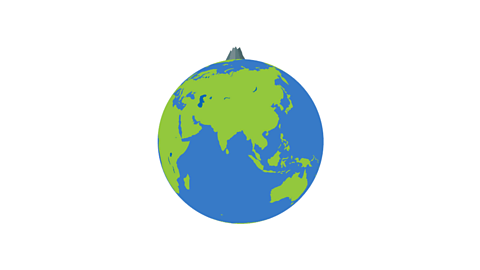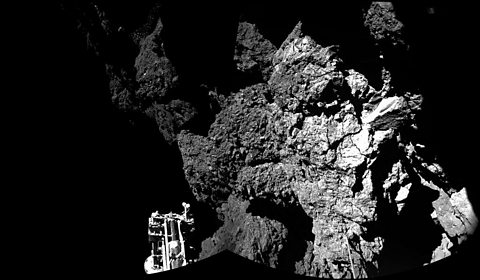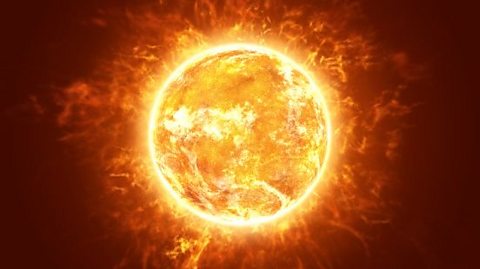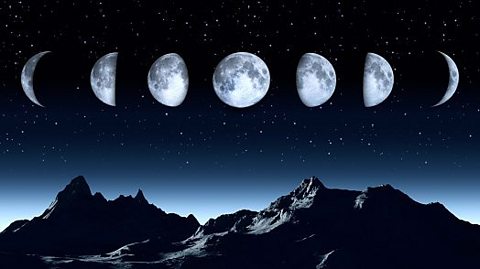Key points
- The solar system is made up of the Sun (our nearest star) and the objects that orbit around it, including planets, asteroids and comets.
- Planets orbit the Sun in roughly circular paths, and moons orbit around planets.
- Asteroids and comets move in paths which are more oval in shape.
- The SunÔÇÖs gravity holds all of these objects together, and the gravitational forces between objects can cause less massive objects to orbit more massive objects.
Solar system activity
Play this game to explore some key facts and figures about the solar system.
Features of the solar system
The term The solar systemThe sun and the objects orbiting around it. This includes planets, asteroids, comets and more. means the Sun and all the objects that orbitThe path an object takes when it moves in space around a star, planet or moon. Objects are held in orbit by the force of gravity. around it. This includes:
- eight planetPlanets orbit stars and can be made of solid or gaseous material. Planets are massive enough to become rounded in shape (due to their own gravity pulling on them).
- many moonMoons orbit planets and most planets in the solar system have moons. The only planets that do not have moons are Mercury and Venus ÔÇô Saturn has 82 known moons.
- five dwarf planets
- asteroidAsteroids are rocky objects which orbit the Sun. Most asteroids are found in the asteroid belt, between the orbits of Mars and Jupiter.
- cometComets are icy objects that are usually found in the outer solar system. Comets produce long tails if they pass close to the Sun, which can look quite spectacular from Earth.
- gas
- dust
At the centre of the solar system is the Sun ÔÇô our nearest starAn enormous ball of gases which produces large amounts of heat and light, due to nuclear fusion reactions in its core.. The Sun is a medium-sized star and is far closer to Earth than other stars. This is why it appears much larger and brighter than other stars. If the Sun were as far away as Proxima CentauriThe next nearest star, after the Sun. the next nearest star, it would be too small and dim to see.
The Sun contains most of the massA measure of the amount of matter an object is made out of. Mass is measured in kilograms (kg). in our solar system. Although the Sun is not particularly large for a star (an equatorial circumference 4.3 million km across), it is very big and very massiveAn object with a large mass, such as a star, planet or moon. compared to the planets.
The SunÔÇÖs enormous mass creates a strong gravitational field around it, which causes smaller objects like planets, asteroids and comets to orbit around it in ellipseA shape that looks like an oval or a squashed circle. The planets in our solar system orbit in elliptical paths which are roughly circular. Comets orbit in highly elliptical paths - a longer oval shape. paths. Planets orbit in roughly circular paths around the Sun, whereas asteroids and comets follow paths which are more oval in shape.
Planets
Terrestrial planets
The four planets that orbit closest to the Sun are:
- Mercury
- Venus
- Earth
- Mars
These planets are known as terrestrial planetsThe inner planets of the solar system, which orbit closest to the Sun and are made of rock and metal. and are made mostly of rock and metal. The word terrestrial means ÔÇśearth-likeÔÇÖ, and these planets all have solid surfaces.
Most terrestrial planets have atmospheres, but the conditions on their surfaces would not allow humans to survive there.
Venus is the hottest planet in our solar system (despite being further from the Sun than Mercury), due to the high levels of greenhouse gases in its atmosphere. It has a surface temperature of over 470┬░C.
Only two of the terrestrial planets have moons orbiting them:
- Earth has one moon
- Mars has two moons ÔÇô Phobos and Deimos
Gas giants
There are four more planets much further from the Sun:
- Jupiter
- Saturn
- Uranus
- Neptune
These planets are called the gas giantsThe outer planets of the solar system, which orbit further from the Sun and are made of gases (mostly hydrogen and helium). and they are very massiveAn object with a large mass, such as a star, planet or moon., and many times larger than the terrestrial planetsThe inner planets of the solar system, which orbit closest to the Sun and are made of rock and metal.. They are made of mostly hydrogen and helium gas, and they are all surrounded by rings and moons.
Jupiter is the largest planet in the solar system and has 79 moons. The four largest moons of Jupiter (Io, Europa, Ganymede, and Callisto) can be seen from Earth with just a pair of binoculars.
Saturn is almost as large as Jupiter and has 82 moons. It has a system of rings orbiting around it, which are made up of rock and icy debris.
The relative sizes of the planets
It can be difficult to visualise the comparative sizes of all the planets in the solar system, so we have used different sized fruits and vegetables to help you. If Earth was the size of a cherry tomato, what size would the other planets be? Click or tap the image below to find out!
How long does it take for Uranus to orbit the Sun?
A year is the length of time it takes a planet to orbit the Sun. The planet Uranus takes about 84 Earth years (or 30,688 Earth days) to complete one orbit around the Sun.
A day on Uranus is 17.25 Earth hours long. This is how long it takes Uranus to complete a single rotation on its axis. This means that Uranus has shorter days than on Earth but much longer years. A year on Uranus is 42,718 Uranus days long!
Asteroids, comets and dwarf planets
Asteroids
Between the orbits of the terrestrial planets and the gas giants, there are millions of asteroids ÔÇô rocky objects that orbit the Sun and vary in size from 1km to around 1000km.
Most of the asteroids in the solar system are found between the orbits of Mars and Jupiter, in a region called the asteroid beltThe region of interplanetary space between the orbits of Mars and Jupiter which is populated by millions of asteroids, located between the inner and outer planets. Some dwarf planets reside here, such as Ceres. .
Like planets, asteroids are mostly made of rock and metal and they orbit the Sun, but asteroids are much smaller than planets so are also known as 'minor planets'.

Dwarf planets
As well as planets and moons, the solar system also contains dwarf planets, which are too small to be considered planets. The best known of these is Pluto, an ice dwarf that orbits far from the Sun, beyond the orbits of Uranus and Neptune.
Pluto was previously classed as the ninth planet from 1930 to 2006, until more dwarf planets were discovered and it was reclassified.
Comets
There are many comets in the outer solar system. Comets are icy objects, which orbit the sun at very large distances.
Comets orbit in paths which are highly ellipseA shape that looks like an oval or a squashed circle. The planets in our solar system orbit in elliptical paths which are roughly circular. Comets orbit in highly elliptical paths - a longer oval shape. and occasionally make their way into the inner solar system, where the SunÔÇÖs intense heat starts to melt them. This produces a large tail made of gases and dust, which can be many millions of miles long which reflects lots of the SunÔÇÖs light, causing them to glow brightly.

What is Halley's comet?
Halley's Comet is a very famous comet that was first recorded as being visible from England in 1066, prior to the Battle of Hastings, although it had been observed by Chinese and Greek astronomers many hundreds of years before that. Halley's Comet returns every 75-6 years and was last seen in 1986. It will return in 2061.
Orbits
All objects exert gravitational forces on each other, causing them to be attracted together.
These forces can become very large when the objects have a high mass, like stars, planets or moons. As well as holding planets and asteroids in orbit around the Sun, these gravitational forces hold moons and satellites in orbit around planets.
To understand how gravityGravity is an attraction force that pulls things toward one another. This size of the gravitational attraction is related to the mass of an object. can cause an object to stay in orbit, it is useful to look at Isaac NewtonÔÇÖs thought experiment NewtonÔÇÖs cannonballA well-known thought experiment devised by Isaac Newton, which led to a better understanding of orbits..
NewtonÔÇÖs cannonball

Image caption, Newton imagined a mountain that was taller than the EarthÔÇÖs atmosphere, so he didnÔÇÖt have to think about air resistance affecting the cannonball.
Image caption, Newton then imagined firing a cannon directly forwards from the mountain, and realised that the cannonball would be pulled towards the Earth by gravity ÔÇô so it would follow a curved path and land at point A.
Image caption, If the cannonball was fired at a higher speed then the path would be less curved, so it would land at B.
Image caption, Newton realised that, if fired at the correct speed, the cannonball would follow a path that had the same curve as the EarthÔÇÖs surface (path C), so it would be constantly falling but never getting any closer to the ground, so it would never land meaning the cannonball would be in orbit.
1 of 4
Artificial satellites and space probes
In addition to planets and moons, many artificial satellites orbit around the Sun and the planets.
These are objects or machines that have intentionally been launched into orbit.
Artificial satellites have many uses, including: navigation, observing Earth, monitoring weather, space telescopes, and relaying communications signals. Some satellites, like the International Space Station, even carry humans.

Space probes are sometimes sent to explore further into outer space. These are robotic spacecraft which often fly past, or land on, other planets and moons ÔÇô or even travel much further, away from our solar system.
Space probes have been sent to observe the outer solar system, sample the SunÔÇÖs atmosphere and even to visit a comet.

What item does Voyager 1 carry onboard in case it is discovered by aliens?
Voyager 1 was launched in 1977 to explore the outer planets in our solar system. After completing that mission, it continued to travel onwards and entered interstellar space in August 2012. The spacecraft carries a special golden record containing voices and music from Earth, in case it is ever discovered by aliens!
Test your knowledge
Play the Atomic Labs game! gamePlay the Atomic Labs game!
Try out practical experiments in this KS3 science game.

More on Space
Find out more by working through a topic
- count2 of 9

- count3 of 9

- count4 of 9

- count5 of 9
